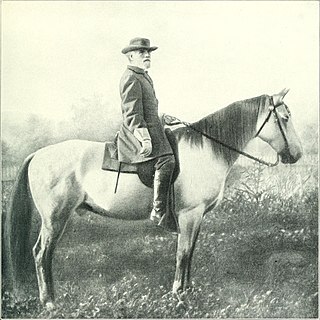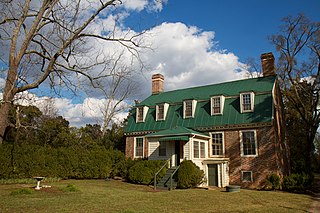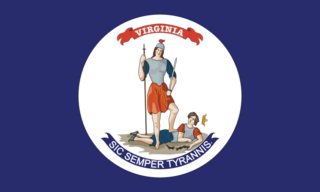
Thomas Jonathan "Stonewall" Jackson served as a Confederate general (1861–1863) during the American Civil War, and became one of the best-known Confederate commanders after General Robert E. Lee. Jackson played a prominent role in nearly all military engagements in the Eastern Theater of the war until his death, and had a key part in winning many significant battles.

West Virginia is a state in the Appalachian, Mid-Atlantic and Southeastern regions of the United States. It is bordered by Pennsylvania to the northeast, Maryland to the east and northeast, Virginia to the southeast, Kentucky to the southwest, and Ohio to the northwest. West Virginia is the 41st-largest state by area and ranks 38th in population, with a population of 1,795,045 residents. The capital and largest city is Charleston.

The Ridge-and-Valley Appalachians, also called the Ridge and Valley Province or the Valley and Ridge Appalachians, are a physiographic province of the larger Appalachian division and are also a belt within the Appalachian Mountains extending from southeastern New York through northwestern New Jersey, westward into Pennsylvania and southward into Maryland, West Virginia, Virginia, Kentucky, Tennessee, Georgia and Alabama. They form a broad arc between the Blue Ridge Mountains and the Appalachian Plateau physiographic province. They are characterized by long, even ridges, with long, continuous valleys in between.

The Second Battle of Winchester was fought between June 13 and June 15, 1863 in Frederick County and Winchester, Virginia as part of the Gettysburg Campaign during the American Civil War. As Confederate Lieutenant General Richard S. Ewell moved down the Shenandoah Valley in the direction of Pennsylvania, his corps defeated the Union Army garrison commanded by Major General Robert H. Milroy, capturing Winchester and numerous Union prisoners.

The Third Battle of Winchester, also known as the Battle of Opequon or Battle of Opequon Creek, was an American Civil War battle fought near Winchester, Virginia, on September 19, 1864. Union Army Major General Philip Sheridan defeated Confederate Army Lieutenant General Jubal Early in one of the largest, bloodiest, and most important battles in the Shenandoah Valley. Among the 5,000 Union casualties were one general killed and three wounded. The casualty rate for the Confederates was high: about 4,000 of 15,500. Two Confederate generals were killed and four were wounded. Participants in the battle included two future presidents of the United States, two future governors of Virginia, a former vice president of the United States, and a colonel whose grandson became a famous general in World War II.

Robert Emmett Rodes was a Confederate general in the American Civil War, and the first of Robert E. Lee's divisional commanders not trained at West Point. His division led Stonewall Jackson's devastating surprise attack at the Battle of Chancellorsville; Jackson, on his deathbed, recommended that Rodes be promoted to major general. Rodes then served in the corps of Richard S. Ewell at the Battle of Gettysburg and in the Overland Campaign, before that corps was sent to the Shenandoah Valley under Jubal Early, where Rodes was killed at the Third Battle of Winchester.

The Battle of Cool Spring, also known as Castleman's Ferry, Island Ford, Parker's Ford, and Snicker's Ferry, was a battle in the American Civil War fought July 17–18, 1864, in Clarke County, Virginia, as part of the Valley Campaigns of 1864. The battle was a Confederate victory.

The Battle of Moorefield was a cavalry battle in the American Civil War, which took place on August 7, 1864. The fighting occurred along the South Branch of the Potomac River, north of Moorefield, West Virginia, in Hardy County. The National Park Service groups this battle with Early's Washington Raid and operations against the B&O Railroad, and it was the last major battle in the region before General Philip Sheridan took command of Union troops in the Shenandoah Valley. This Union triumph was the third of three major victories for Brigadier General William W. Averell, who performed best when operating on his own.

Traveller (1857–1871) was Confederate General Robert E. Lee's most famous horse during the American Civil War. He was a grey American Saddlebred of 16 hands, notable for speed, strength and courage in combat. Lee acquired him in February 1862, and rode him in many battles. Traveller outlived Lee by only a few months, and had to be shot when he contracted untreatable tetanus.

The Battle of Totopotomoy Creek, also called the Battle of Bethesda Church, Crumps Creek, Shady Grove Road, and Hanovertown, was a battle fought in Hanover County, Virginia on May 28–30, 1864, as part of Union Lt. Gen. Ulysses Grant's Overland Campaign against Confederate Gen. Robert E. Lee's Army of Northern Virginia.

Lucius Morris Beebe was an American author, gourmand, photographer, railroad historian, journalist and syndicated columnist.
The Battle of Buffington Island, also known as the St. Georges Creek Skirmish, was an American Civil War engagement in Meigs County, Ohio, and Jackson County, West Virginia, on July 19, 1863, during Morgan's Raid. The largest battle in Ohio during the war, Buffington Island contributed to the capture of the famed Confederate cavalry raider, Brig. Gen. John H. Morgan, who was seeking to escape Union army pursuers across the Ohio River at a ford opposite Buffington Island.
Edward Retz "Eddie" Maple is a retired American thoroughbred horse racing jockey. One of eight brothers and sisters, he was an older brother to jockey Sam Maple who won more than 2,500 races. He began riding horses at age 12 and won his first race as a professional at 17. He went on to be one of the top jockeys in the United States and a National Hall of Fame inductee.
The Battle of Fairfield was a cavalry engagement during the Gettysburg Campaign of the American Civil War. It was fought July 3, 1863, near Fairfield, Pennsylvania, concurrently with the Battle of Gettysburg, although it was not a formal part of that battle. While a minor fight by the small number of troops deployed, strategically, the Confederate victory secured the important Hagerstown Road, which Robert E. Lee's Army of Northern Virginia would use on July 5 to return to Maryland and then on to safety in Virginia.

The Alco T6 was a diesel-electric locomotive of the switcher type rated at 1,000 horsepower (750 kW), that rode on two-axle trucks, having a B-B wheel arrangement.

Robert Homer Mollohan was a former member of the United States House of Representatives. A Democrat from West Virginia, Mollohan was succeeded in Congress by his son, Alan.

The U.S. Military Railroad (USMRR) was established by the United States War Department as a separate agency to operate any rail lines seized by the government during the American Civil War. An Act of Congress of 31 January 1862 authorized President Abraham Lincoln to seize control of the railroads and telegraph for military use in January 1862. In practice, however, the USMRR restricted its authority to Southern rail lines captured in the course of the war. As a separate organization for rail transportation the USMRR is one of the predecessors of the modern United States Army Transportation Corps.
Mario G. Pino is a jockey in American Thoroughbred horse racing. Raised on a farm, he began his riding career in 1978 at Delaware Park in Wilmington. Over the years, he has chosen to be based at race tracks close to home and family and has won a number of riding titles at venues in the Delaware, Maryland, and Virginia areas.

Heaton's Crossroads, also known as the Purcellville Wagon Raid, was an American Civil War skirmish that took place between Federal cavalry under Brig. Gen. Alfred N. Duffié and Confederate infantry under Maj. Gen. John C. Breckinridge on July 16, 1864, near present-day Purcellville, Virginia in Loudoun County as part of the Valley Campaigns of 1864. The action was tactically inconclusive.

The 7th Virginia Cavalry Regiment also known as Ashby's Cavalry was a Confederate cavalry regiment raised in the spring of 1861 by Colonel Angus William McDonald The regiment was composed primarily of men from the counties of the Shenandoah Valley as well as from the counties of Fauquier and Loudoun. Two companies contained men from the border counties of Maryland.

















